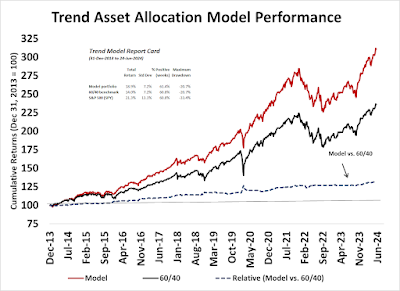The Trend Asset Allocation Model is an asset allocation model that applies trend-following principles based on the inputs of global stock and commodity prices. This model has a shorter time horizon and tends to turn over about 4-6 times a year. The performance and full details of a model portfolio based on the out-of-sample signals of the Trend Model can be found here.

My inner trader uses a trading model, which is a blend of price momentum (is the Trend Model becoming more bullish, or bearish?) and overbought/oversold extremes (don't buy if the trend is overbought, and vice versa). Subscribers receive real-time alerts of model changes, and a hypothetical trading record of the email alerts is updated weekly here. The hypothetical trading record of the trading model of the real-time alerts that began in March 2016 is shown below.

The latest signals of each model are as follows:
- Ultimate market timing model: Buy equities (Last changed from “sell” on 28-Jul-2023)*
- Trend Model signal: Bullish (Last changed from “neutral” on 28-Jul-2023)*
- Trading model: Neutral (Last changed from “bullish” on 23-May-2024)*
Update schedule: I generally update model readings on my site on weekends. I am also on X/Twitter at @humblestudent. Subscribers receive real-time alerts of trading model changes, and a hypothetical trading record of those email alerts is shown here.
Subscribers can access the latest signal in real time here. Too far, too fast?Has the bull run gotten ahead of itself? The S&P 500 was up 14.5% for the first half. In addition, Ryan Detrick observed that the Zweig Breadth Thrust signal of early November showed very strong returns. It was a buy signal I also highlighted (see Zweig Breadth Thrust: From caution to YOLO). The S&P 500 was up 19.0% in the six months since the buy signal, and the market was up 3.5% since then. Combined, investors would be up nearly 22.5% since the buy signal, which is just under the 12-month average and median return.

In light of these strong returns, how much gas is left in the bulls’ gas tank? Is this the case of the market going up too much, too fast? The full post can be found here.
